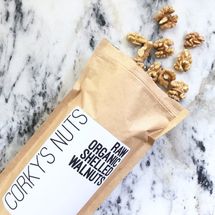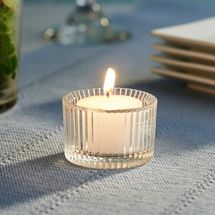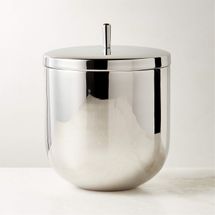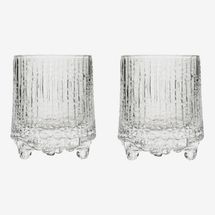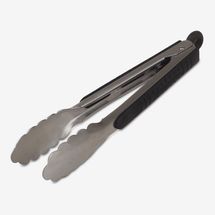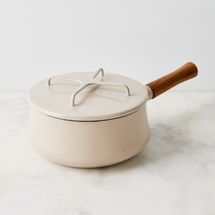
Hosting can be a lot, especially when part of the game is having the soirée you put together look effortless. In this series, veteran party-throwers tell us how they pull off their highly specific, flawlessly executed gatherings. This installment comes from Amy Thielen, author of the recently released cookbook Company, who shares how to plan, execute, and bundle up for a cold-weather grilling party.
Amy Thielen lives in the woods in northern Minnesota. It gets cold — like into the negatives cold — in the fall and doesn’t let up until almost May. By February or March, she’s over it. “That’s too long not to cook outside,” she says. “You have to grill in the winter.”
She does this often in the latter part of the season, and it was the impetus for the specific dinner-party menu for six to eight people that she developed for her cookbook. The main event is a whole chicken roasted, legs up, in a Bundt pan (à la beer-can chicken, but without the beer), over fire. The juices collect at the bottom, which she turns into a bagna cauda butter sauce. She tends to it — adding wood chips to the charcoal, basting, temperature checking — while friends join her outside with whiskey and lap blankets. It’s like an extended happy hour, laid out in much the same way a late-afternoon-into-nighttime barbecue would be in peak summer.
The other dishes — deviled-egg dip, Fun House baked potatoes, sweet-and-sour marinated peppers with Swiss chard, and sopped greens with butter-roasted walnuts — can mostly be done ahead in the comfort of the kitchen. “The whole point is that once you get the chicken going and your friends are there, everything is set up in such a way that’s already completely done or super fast and easy to pull off without much thinking,” she says. Here, Thielen details how to pull off the evening seamlessly. Even for those of us who live in slightly more temperate climates, it’s a good reminder to pull on a coat, grab our tongs, and cook outside.
Two days before: Menu plan
I usually start with an ingredient that I have that’s really primo. Sometimes that’s a protein, or sometimes it’s a vegetable. It doesn’t really matter — but something I want to highlight that excites me and gets my creative juices flowing. So in this case, it was the chicken that started this menu (I buy mine from a local farm.) This recipe came about because it is kind of like a beer-can chicken, but I’m using a Bundt pan that collects all the juices, kind of like a moat. Then you have that to make a sauce — this anchovy, lemony, herb-y sauce.
From there, I know I want something to absorb the sauce: potatoes. These are my take on one of my mom’s go-to baked-potato recipes. And then I want the other sides to go together in a casual single plate. In this case, that’s the peppers and the greens.
One day before: Grocery shop
All of the ingredients in this menu you can find at your local store, but there are a few that I think you should try to get particularly high-quality versions of; they really can make a dish (in this case, as the topping for the kale). I’ve gotten very picky about walnuts because I have cooked with and generally just had one too many rancid walnuts. And I find that a lot of walnuts that are stored in the baking aisle or sold from the baking aisle, they’re not that fresh. To be treated just really well, they need to be refrigerated. You can buy from somewhere that refrigerates their walnuts, or from somewhere that harvests their nuts the previous fall, which is when they’re in season.
You also want really good anchovies, which go into the sauce for the chicken. I live in northern Minnesota, so the anchovies that I can buy in the store are quite bottom-of-the-barrel and aren’t that popular, so they sit on the shelf kind of a long time. So that’s something that I mail-order.
The day before, I pre-salt the chicken and put it in the fridge, which seasons the meat and draws out moisture. I leave it uncovered, though, so the skin doesn’t get too flabby. Really, you can do this up to 48 hours in advance, but overnight is great. Other than that, everything can be done the day of your party.
Day of
12 p.m.: Set the table
My husband sets the table — it’s a nice thing to get out of the way. I like to have the food out buffet-style on a separate counter, so on the dining table are the plates, flatware, napkins, and glasses.
The only extras I really do are candles — the low, short ones. I like dim lighting because it makes a cozy environment that brings everybody together. And then maybe I’ll have flowers. There’s an abundance of flowers in the summer, but in the winter, I do what I can. I like these frog pins to place in vases and prop up the stems. You can have one or two or three stems. They can be cheap and small and from the grocery store, but they still look good.
I also like to make a little bar area with a stainless-steel ice bucket and put some glasses next to that. We have wine but also like whiskey for this longish cocktail hour where people are standing around the grill and it’s cold. It’s not a Minnesota winter dinner party without Roknar. And these glasses are so cute — like a highball but with little feet.
1 p.m.: Wash your vegetables
First things first, I wash all my vegetables: Swiss chard, kale, peppers, rosemary, and basil. Then I lay them out on a dish towel to dry. It’s good to get this out of the way.
2:30 p.m.: Start with deviled-egg dip
Then I’m making the deviled-egg dip — and if you’re one of those people (like me) who lick the center of the deviled egg, you’re going to love this. It’s delicious. It’s also a dip for those of us who are sick of peeling eggs perfectly. In fact, for this recipe, you can just poach the eggs, cooking them five or six minutes in simmering water, or you can peel them roughly and just not care what they look like.
It’s eight eggs — two whole and the rest of the yolks — puréed in a food processor with five tablespoons mayonnaise, two tablespoons lemon juice, one tablespoon Dijon mustard, one tablespoon Worcestershire sauce, half a teaspoon of sea salt, and pepper. You purée it all until it’s soft and luscious. I also chop two leftover egg whites to use as garnish, along with capers and Aleppo pepper. Then I package everything up in storage containers and put it in the fridge. I’ll plate it before I serve.
3:30 p.m.: Make the potatoes
You can find the full recipe for my baked potatoes online here, but they’re pretty simple. You’re going to scrub five large yellow potatoes and cut them in half lengthwise. Then you want to score each piece halfway through the flesh, in a crosshatched pattern. Place them cut-side up in a baking dish, and season with salt and pepper to taste. A low-sided steel baking pan will ensure crispy bottoms.
Then you make a quick flavored butter to smear on top and melt in the oven, down the cracks of the crosshatching to the bottom skins. Mash one stick of softened butter with a clove of grated garlic, half a teaspoon of paprika, a fourth of a teaspoon of smoked paprika. Spread half of the butter mixture on top of the potatoes. You’ll apply the rest of the butter halfway through baking, along with a thin slice of sweet onion, which you can prep now, too. All of this can sit on the counter until you’re ready to bake.
4:30 p.m.: Make the marinated peppers
Now you want to sauté a pound of semisweet frying peppers — of various colors and varieties if you can find them — in a little olive oil in a large stainless-steel or cast-iron skillet over medium heat. Season with salt and fry until you see some browning on both sides, then cover the pan, reduce the heat to medium-low, and cook, checking often, until they’re tender and have gone completely slack. This should take about 20 minutes. Lift out the peppers and set them aside.
Raise the heat to medium-high, and add one large sweet onion cut into arcs, one tablespoon of butter, another half-teaspoon of salt, and some black pepper. Fry the onion until the tips start to brown, then reduce the heat again and cook until lightly caramelized, about 15 minutes. Add one tablespoon of minced fresh rosemary and the leaves of one bunch of Swiss chard and cook just until they begin to wilt. Return the peppers to the pan, nestling them into the onions, and add a teaspoon of honey, a tablespoon of red wine vinegar, a fourth of a teaspoon of hot pepper flakes, one tablespoon lemon juice, and two tablespoons of olive oil. Cook for just another minute or two, turning everything together in the pan with a pair of tongs, until the flavors meld.
Arrange everything on a shallow platter and set aside at room temperature until dinner, when you’ll finish it off with a few torn basil leaves.
5 p.m.: Roast the walnuts
And you can make your butter-roasted walnuts now, because they’ll hold for a few hours. It’s a slow — let’s say leisurely — process. Slowly roast the walnuts in a small cast-iron pan, which maintains steady heat, with a couple of tablespoons of olive oil, a couple of tablespoons of butter, a clove of smashed garlic, and a couple of sprigs of rosemary. And you just kind of turn and turn and turn with a spoon until they turn a dark-amber color. It’ll take about 20, 25 minutes. And then you just shove those to the back of the stove, and forget about them until you need them.
5 p.m. Get the grill going
Most grills take about 30 minutes to preheat, so you want to run outside and get that going. This is a good time to say that the exact timing of this recipe will depend on what type of grill you have and the size of your chicken. I used to use a Big Green Egg, and now I have a Kamado Joe. But this will work with any charcoal grill, even the basic Weber. You just need one that’s big enough to have a hot side directly above coals and a cooler side with nothing underneath, which you should prepare once your coals go in.
Once that’s going, take the deviled-egg dip out of the fridge and plate it. I like to spread the dip on a platter. This way it comes to room temperature faster — in just about a half-hour. And it looks nice.
There’s a whole world of Norwegian flatbreads that I’ve started to get into — I like them because they’re designed to be dry and stay good for months on end. So I have a little collection of favorites, including these. But even in any store, you can always buy Wasa, which sometimes I’ll crisp up even further in the oven.
You can put your ice and wine in the bucket, too. And then any last-minute things, like lighting candles.
5:30 p.m.: Put the chicken on
I rub the chicken with the cut side of a lemon. In the well of my Bundt pan, I place two lemon halves, ten sage leaves, two bay leaves, garlic cloves from one head (unpeeled; you’ll squeeze out the cooked garlic pulp later), two anchovies, three tablespoons of butter, and a third of a cup of white wine. I set the chicken on the center pivot of the Bundt pan, haunches down, breasts up.
I gather the rest of the tools I’ll need on a quarter-sheet tray to easily carry outside: tongs, a basting brush, hot pads, and a thermometer for testing the doneness of the bird toward the end. The day will come that someone will put your expensive internal-read thermometer into the dishwasher — probably sooner rather than later. Brokenhearted once, I now buy cheap Taylor thermometers, often, at the grocery store.
Then it’s just about bundling up, but in such a way that I can go back and forth without it being too annoying. In the winter here, it is straight boots to slippers all the time. So it’s really important for me to have boots that I can slip on and off. I am not lacing a boot. I have these from Steger Mukluks. The company is based out of Minnesota and they’re used by Antarctic explorers. They’re quite well known, but you can slip in and out. And they have a rubber bottom for ice. The best socks are Darn Tough socks. They’re ugly, though. Fox River socks are second-best (and classic).
6 p.m.: Guests arrive
People arrive not long after I put the chicken on the grill. The vibe is that I might be standing by the chicken, keeping tabs on it. But I’m also going in and out of the door a fair amount. My husband’s probably sitting outside smoking a cigar. Guests might pour themselves a drink and come stand outside with me, or hang inside to snack and drink.
We keep these lap blankets outside for people who want to sit around. Shawls and throws are not our style. We’re much more into knitted afghans, a lot of which you can find vintage on eBay, too. And I like this wine cover to keep red wine from getting too cold if we bring a whole bottle out. I really dislike red wine served too warm, above cellar temperature, but when grilling outside, it may actually need a little warm-up.
6:30 p.m.: Finish the last-minute cooking
All this time, I’m trying to maintain a grill temperature of 300 to 325 degrees. I start the chicken on the hot side for 30 minutes with the lid closed. Then I baste it with the liquid gathered at the bottom of the pan, add half a cup of damp apple or maple-wood chips to the grill, then close and cook for another 30. I do the same thing over again, basting and adding the second half of the wood chips, and cover. A four-and-a-half-pound chicken will take about one and a half hours to cook through.
As the chicken is grilling, I go inside to preheat the oven for the baked potatoes. Those bake at 350 degrees for about 30 to 40 minutes. Then you turn the heat up to 450 degrees, top them with the rest of the compound butter and onion slices, and pop them back in for about 25 minutes to finish.
The kale is the only dish that needs to be made closer to serving time — but if you set yourself up, it’s a quick operation. Put a large pot of water on the stove and set it boil now.
7:30 p.m.: Bring the chicken in
Once the chicken reaches temperature — the skin will look burnished, the wings will feel loose in their sockets, and an instant-read thermometer inserted into the thickest part of the thigh should read 160 degrees — I bring it inside and transfer it onto a cutting board. It should rest for about 15 minutes, enough time to finish off the sauce. I tip the juices that have collected at the bottom of the Bundt pan into a small saucepan, fishing out the garlic and squeezing the now-softened insides into the juices, and add three more anchovies, mashing them into the bottom of the pot to break them up. I squeeze in the juice from the hot lemons, add a fourth of a cup of milk to loosen the sauce, and season with about ten turns of freshly ground pepper. This should simmer gently for a minute, for the flavors to come together. Top it off with a fresh swig of olive oil, remove from the heat, and taste. Add more lemon and salt as needed.
We’re close to the end now; time to boil the kale. Salt the water you set up on the stove earlier — heavily, so the kale tastes seasoned after draining — and throw in the torn kale. Boil rapidly for about four to five minutes, or until tender at the stem. Using a skimmer, transfer the kale from the pot to a colander set over a bowl to let it steam off for a minute. Then arrange it on a serving platter, unfurling the leaves, top with the walnuts (and their seasoned butter), and garnish with a few lemon wedges.
I pile everything else onto serving platters and dishes at this point, as well.
Finally, I carve the chicken. You’re going to pour that sauce around the chicken and under it. And then over the white meat that doesn’t have skin on it potentially — but you don’t want to sop the skin too much. And then you want to serve that with a spoon for tipping that platter and making sure people take some of that delicious sauce.
The Strategist is designed to surface the most useful, expert recommendations for things to buy across the vast e-commerce landscape. Some of our latest conquests include the best acne treatments, rolling luggage, pillows for side sleepers, natural anxiety remedies, and bath towels. We update links when possible, but note that deals can expire and all prices are subject to change.

